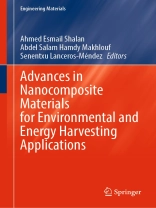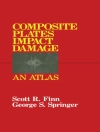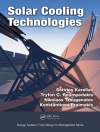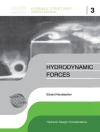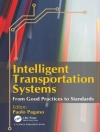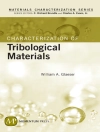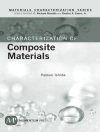This book discusses the fundamental, synthesis, properties, physico-chemical characterizations and applications of recently explored nanocomposite materials. It covers the applications of these different nanocomposite materials in the environmental and energy harvesting fields. The chapters explore the different techniques used for preparation and characterization of several types of nanocomposite materials for applications related to environmental and energy pathways. This book presents a panorama of current research in the field of nanocomposite structures for different applications. It also assesses the advantages and disadvantages of using different types of nanocomposite in the design of different material products. The comprehensive chapters explain the interactions between nanocomposite materials and mechanisms related to applications in environmental pollution and energy shortage.
Tabela de Conteúdo
Part I Fundamental of nanocomposite materials synthesis and production.- 1: Nanocomposites materials and their applications: current and future trends.- 2: Versatile production of new multi-functional and composite nanomaterials by means of cold plasma – liquid interactions.- 3: Carbon Nanostructure Based Composites for Environmental and Energy Applications.- 4: A novel synthesis of gold nanoparticles-layered double hydroxides nanocomposites through in-situ reductive adsorption of gold(III) ion on organic acid-functionalized Mg/Al layered double hydroxides.- 5: Graphene and its nanocomposites derivatives: synthesis, properties, and their applications in water treatment, gas sensor, and solar cell fields.- 6: Bionanocomposites and their applications in energy Harvesting and deletion of environmental pollutions.- 7: A comparative study of cellulose nanocomposite derived from algae and bacteria and its applications.- Part II Advances in nanocomposite materials for environmental applications.- 1: Polymeric nanocomposite membranes for water remediation: from classic approaches to 3D printing.- 2: Biodegradable polymeric nanocomposites for wastewater treatment.- 3: Functionality-structure relationship into functional polymeric nanocomposite membranes for removal and monitoring of pollutants in fluid phases.- 4: Polymer-based nanocomposites for removal of pollutants from different environment using catalytic degradation.- 5: Role of Graphene oxide based Nanocomposites in Arsenic purification from Ground Water.- 6: Green Nanocomposites: Magical Solution for Environmental Pollution Problems.- 7: Recent Developments in Wastewater Treatment using Polymer/Clay Nanocomposites.- 8: Applications of nanocomposites in environmental remediation.- 9: Removal of radioactive waste from water using polymer nanocomposites.- Part III Advances in nanocomposite materials for energy harvesting applications.- 1: Mixed ionic-electronic conductors based on polymer composites.- 2: Nanocomposites for energy storage applications.- 3: Metal Sulfide Nanocomposites for Energy Harvesting Applications.- 4: Advanced Neutron and Synchrotron Characterization Techniques for Nanocomposite Perovskite Materials toward Solar Cells Applications.- 5: Development of Hierarchical nanostructures for Energy Storage.- 6: Polymer Nanocomposites for Energy Storage Applications.- 7: Incorporation of Nanocomposite Thin Films as effective electrodes for Photovoltaic Devices Applications.- 8: Recent advances of Ti O
2 nanocomposites for photocatalytic degradation of water contaminants and rechargeable Sodium ion batteries.- 9: Major trends and mechanistic insights for the development of Ti O
2-based nanocomposites for visible-light-driven photocatalytic hydrogen production.- 10: Polymer/Carbon nanocomposites: synthesis, properties and application in solar energy.- 11: Graphene based nanocomposites: Synthesis, characterization and energy harvesting applications.- 12: Design of new High Energy Near field Nanophotonic materials for far Field applications.- 13: Supramolecular Structures of Organic Molecules-Single Walled Carbon Nanotube Nanocomposites.- 14: Structure and Properties Manipulations of Graphene: towards Developing High Sensitivity Optical and Electrical Sensors.- 15: Bulk and Nanocomposite Thermoelectrics: Synthesis, Properties, and applications.- 16: Nanodiamond/conducting polymer nanocomposites for Supercapacitor applications.- 17: Supercapacitors: current trends and future opportunities
Sobre o autor
Ahmed Esmail Shalan is Juan de la Cierva Fellow at BCMaterials, Basque Center for Materials, Applications, and Nanostructures, Leioa, Spain. He obtained his BSc (2008) and MSc (2012) in Materials Science from Ain Shams University, Egypt and his Ph D (2017) from Hokkaido University, Japan. He is a Researcher at Central Metallurgical Research & Development Institute (CMRDI), Egypt (now, on leave). He obtained several awards and prizes like attending 69th Lindau Nobel Laureate Meeting 2019, Egyptian Academy Prize (2018, 2020), Japanese government Ph D scholarship (MEXT, 2013-2017), and fellowships like DAAD fellowship (i-MEET-FAU), Germany (2013). His work reflects his interest in physical chemistry and materials science for energy, environmental and optoelectronic devices applications.
Professor Makhlouf is the Vice President of Advanced Material Research, Stanley Black & Decker, Inc., USA. Before joining Stanley Black & Decker, he was the President of EMC3 – USA, VP of IM2C – USA, Full Professor of Materials Science at Central Metallurgical Research and Development Institute – Egypt, and Full Professor of Manufacturing and Industrial Engineering at the University of Texas – USA. Makhlouf has been included in Stanford University’s List of World’s Top 2% of Scientists, USA, 2020 & 2021. He is also the recipient of numerous national and international prizes and awards including the Humboldt Research Award for Experienced Scientists, at Max Planck Institute, Germany; Fulbright Scholar, NSF, Dept. of Energy Fellowships, USA. Shoman Award in Engineering Science; and the State Prize of Egypt in Advanced Science and Technology, and more.Senentxu Lanceros‐Méndez
Prof. S. Lanceros-Méndez graduated in physics at the University of the Basque Country, Leioa, Spain. He obtained his Ph D from the Institute of Physics of the Julius-Maximilians-Universitat Wurzburg, Germany. He was a Research Scholar at Montana State University, USA, Visiting Scientist at Pennsylvania State University, USA, and University of Potsdam, among others. Since 2016, he is Ikerbasque Professor at the BCMaterials, Basque Center for Materials, Applications and Nanostructures, Derio, Spain. He is an Associate Professor at the Physics Department of the University of Minho, Portugal (on leave), where he belongs to the Center of Physics. From 2012 to 2014, he was also an Associate Researcher at the INL – International Iberian Nanotechnology Laboratory. His work is focused on the area of smart materials for sensors and actuators, energy and biomedical applications. In addition, he has served as both a Senior Editor and board member of many international journals, as well as reviewer for different scientific publishers.
